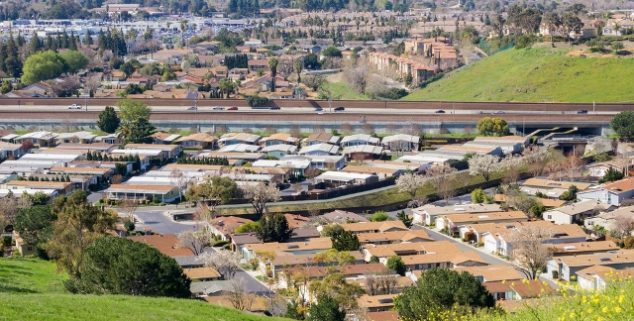Opinion
‘Infill development’ can help solve California’s housing crisis
 View towards Guadalupe Freeway from Communications Hill, San Jose. (Photo: Sundry Photography, via Shutterstock)
View towards Guadalupe Freeway from Communications Hill, San Jose. (Photo: Sundry Photography, via Shutterstock)They say the real estate agent’s mantra is “location, location, location.” And when it comes to crafting smart housing policy, location is key, as well.
As California legislators consider more than 130 bills designed to tackle the state’s housing crisis, they should consider ways to encourage infill housing — compact housing in already urbanized land near transit, jobs, and services.
It would save California 1.79 million metric tons of greenhouse gas emissions every year. That’s like taking 378,000 cars off the road
As detailed in Next 10’s new report, Right Type, Right Place: Assessing the Environmental and Economic Impacts of Infill Residential Development through 2030, infill development meets growing demand for housing in walkable communities and helps families who live there control monthly household costs by trimming travel and utility expenses. And for our state as a whole, an emphasis on infill housing would help spur economic growth and cut greenhouse gas emissions.
In Right Type, Right Place, researchers look toward 2030 by modeling three separate scenarios for California’s housing future. The first is a business-as-usual projection, which would continue existing development patterns by focusing on far-flung, car-dependent housing with an emphasis on single-family homes. The second scenario features much more infill housing and multifamily housing. The third scenario is an infill “target” scenario, in which all new housing development occurs in infill zones, close to school, work, and transit, with an emphasis on multifamily homes.
The target scenario provides more housing that meets market demand for compact, walkable neighborhoods. While rents and home prices would be slightly higher in these neighborhoods on average, monthly household savings on commuting and other travel expenses, along with monthly savings on utilities, would more than make up the difference.
And infill has other advantages for our society. Switching from business as usual to the target scenario would save California 1.79 million metric tons of greenhouse gas emissions every year. That’s like taking 378,000 cars off the road; it would help us meet our climate change and air pollution goals. At the same time, our economy would fare better under the target scenario. Annual growth would be $800 million higher than under the business-as-usual scenario.
It would also improve residents’ quality of life by expanding walkable communities.
But if infill is to play a bigger role in solving California’s housing crisis, state leaders need to prioritize it when developing policies to boost housing. For example, legislators might consider allowing affordable housing developers to override local zoning bylaws in infill neighborhoods that lack sufficient housing, developing a permanent source of funding for affordable housing near transit, and establishing regional tax sharing with benefits for municipalities that meet housing goals. Boosting transportation and transit investments in areas ripe for infill housing development is also critical.
Leaders in communities with prime potential for infill housing have a key role to play, as well. They can ensure that local zoning laws allow more multifamily use, improve mobility and access by reducing excessive parking requirements, and increase allowable density. And they can help by shortening permitting timelines where they’ve grown too long. It’s also important to make sure new infill development doesn’t displace existing residents by supporting affordable housing in communities across the state.
These policy changes are worth prioritizing because an emphasis on infill development can help California meet demand for convenient, compact housing while boosting the economy and meeting our state’s climate change commitments. It would also improve residents’ quality of life by expanding walkable communities, cutting down on vehicle-miles traveled, and lowering household energy bills and transportation costs. Taken together, infill housing offers a golden opportunity to build a better future for the Golden State.
—
Ed’s Note: Ethan Elkind is director of the climate program at the Center for Law, Energy and the Environment at UC Berkeley’s School of Law. Carol Galante is faculty director at the Terner Center for Housing Innovation, a collaboration between the UC Berkeley College of Environmental Design and the Fisher Center for Real Estate and Urban Economics at the Haas School of Business. F. Noel Perry is founder of Next 10, which commissioned this report. Next 10 is an independent, nonpartisan, nonprofit organization that educates, engages and empowers Californians to improve the state’s future.
Want to see more stories like this? Sign up for The Roundup, the free daily newsletter about California politics from the editors of Capitol Weekly. Stay up to date on the news you need to know.
Sign up below, then look for a confirmation email in your inbox.

[…] the release of the new report Right Type, Right Place, Capitol Weekly ran an op-ed from me and co-authors Carol Galante and Noel Perry this week, summarizing some of the benefits of […]